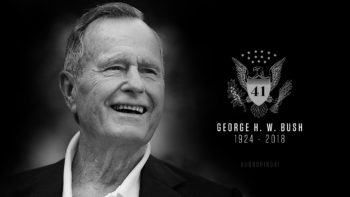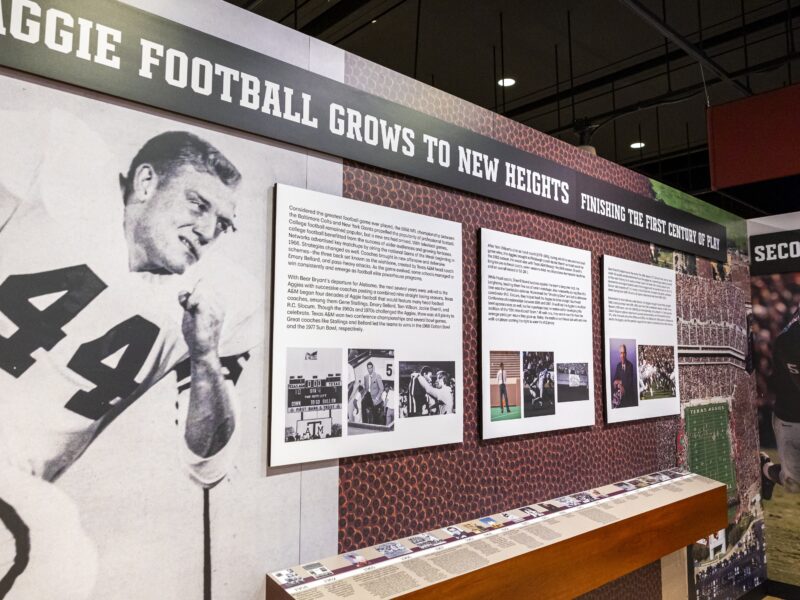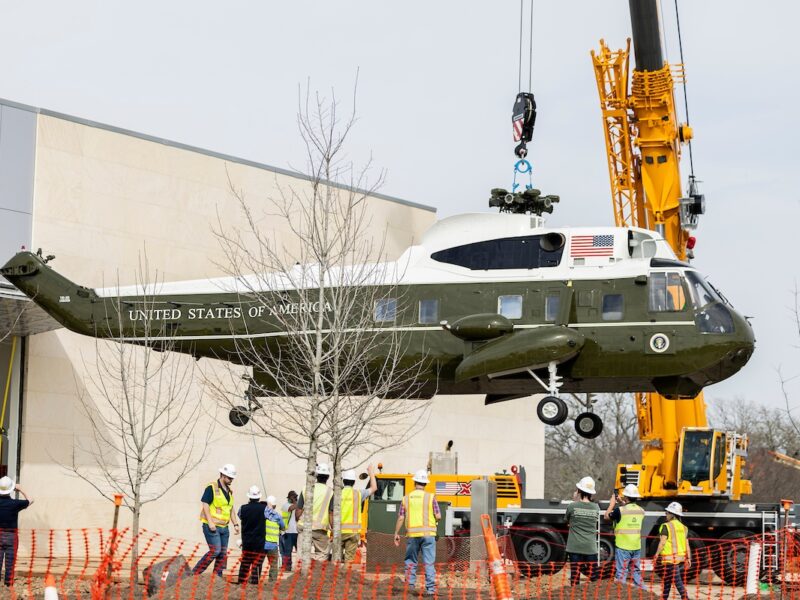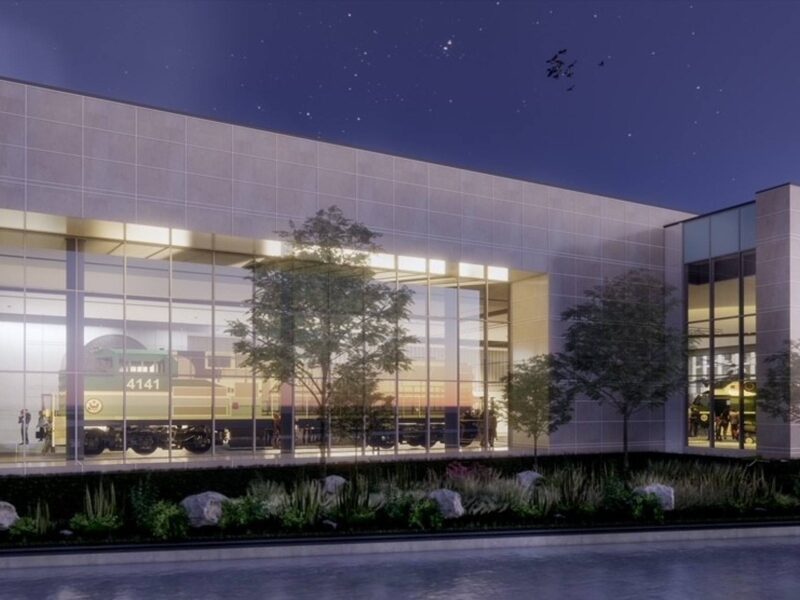Honoring President Bush’s Legacy

Interested in paying their respects and learning more about the life of the 41st president, visitors continued to visit the George H.W. Bush Presidential Library and Museum in the year since he was laid to rest on the Texas A&M University campus.
There’s been an increase in people touring the library and museum, as well as Bush’s gated grave site tucked among the oak trees behind it, said David B. Jones, President and CEO of the George and Barbara Bush Foundation. The visitor traffic “has really been very special,” Jones said, as the foundation that preserves Bush’s legacy of selfless service looks to the future.
It’s been a period of transition for the Bush Foundation since Bush died on Nov. 30, 2018. Meanwhile, at the other institution in Aggieland that bears his name – the Bush School of Government & Public Service – there’s been a recommitment to ensuring the spirit of Bush’s life’s work remains at the core of the school.
“It’s been a year of ensuring that his memory and the lessons that he taught everyone here are cemented in the DNA of the college,” said Bush School Dean Mark Welsh. “There’s no less focus on the things that he did during the course of his career, of the example he set, of the professional values that he espoused and of the way he treated people.”
Moving forward after both the death of Bush and former First Lady Barbara Bush, Jones said the foundation will continue its support of the Bush School and the Bush Library. This new chapter also will bring some visible changes that are consistent with the Bushes’ wishes, Jones said.
“Given who the Bushes were and the way they conducted their lives, we’re doing things exactly the way they would have wanted,” Jones said.
A year of changes
The first visible change came last April, when the George H.W. Bush Presidential Library Foundation changed its name to the George and Barbara Bush Foundation.
“This strong family endorsement of our mission and the steps we are taking to continue our namesakes’ work in bettering our nation will help us better promote value, virtue and nobility of service across their core causes,” Jones said in a statement following the announcement.
Jones said the Bush family was enthusiastic about the name change, which helps reflect the important role the former First Lady played in Bush’s life and career and the foundation’s intention to support all areas of their public service legacies, including the Barbara Bush Foundation for Family Literacy, the Barbara Bush Houston Literary Foundation and Points of Light.
While still headquartered in College Station, the foundation also has opened a satellite location in Houston in the office Bush occupied after his presidency.
Less than a week after the Foundation’s name change, former U.S. Vice Presidents Dick Cheney and Dan Quale and current Vice President Mike Pence visited campus to discuss the American vice presidency – the first major event on campus since the president’s passing.
“This nation owes an extraordinary debt to the life and service of Vice President and President George Herbert Walker Bush,” Pence said during the event. “I am in debt as well for his kindness and his inspiration and his example.”
That summer, 12 of Bush’s 17 grandchildren returned to campus to continue their grandfather’s tradition of parachuting onto the Bush Library grounds. Although high winds cancelled the event, it still gave the large family the rare opportunity to reunite, which they used to lay a wreath at their grandparents’ grave site. Pierce Bush, son of Neil Bush and one of the 12 grandchildren who was set to jump, said it was a special moment.
“My grandparents deeply loved this community, this school, the traditions that came with it — it’s why they chose to have this as their final resting place,” he said.
After the reunions and celebrations came more permanent fixtures that would honor Bush’s legacy.
The first came in June when the U.S. Postal Service unveiled a Forever stamp on what would have been the president’s 95th birthday, continuing a tradition of placing the images of former presidents on postage stamps that began in 1847 with George Washington. Bush Library Director Warren Finch said the president, who was modest to the point that he questioned why so many Bush Library exhibits focused on him, would have been touched by the honor.
On Nov. 30, in recognition of the year since Bush’s passing, Bush School students honored the president with a day of service called “41 Acts of Service: A Day Serving Your Community in Honor of President Bush.” The social media campaign encouraged individuals to serve their communities through selfless acts big and small and document them using the #41ActsOfService hashtag.
The Bush Library and service dog school America’s VetDogs also unveiled a statue on Dec. 2 that honored Sully, Bush’s companion dog that stayed by his side during the final months of his life and rested near his casket after his passing.
“It shows the love and companionship that President Bush had for Sully and they were a source of strength for each other,” Jones said during the event. “There’s no doubt that it will be a very popular new exhibit for the library.”
After a year of memorials, tributes and celebrations, officials from the Bush School and Bush Foundation say even more is in store.
What the future holds
Jones said contributions to the Bush School, as well as memberships, have seen a marked increase since Bush’s death. A major priority will be increasing the Bush School’s endowment by roughly $25 million, he said.
Most of that money will be used for student scholarships and the school’s institutes, including the Scowcroft Institute of International Affairs and the Mosbacher Institute for Trade, Economics and Public Policy.
“That would allow us to get back to where we want to be in terms of support for every student,” Welsh said. “One of President Bush’s big pushes when the Bush School first opened was to make sure that it was as affordable as possible to go along with a quality education, because as people want to graduate from here and go into public service, they can’t afford to have a huge educational bill that they have to repay, or they’re not going to be able to afford to go into public service.”
Welsh said growing the school’s scholarship endowment will allow it to continue to provide students with a reasonable cost of education. It will also fund an internship or language immersion program for every Bush School student.
Jones said a fundraising campaign will be launched next year. Fundraising will also go toward the display for Union Pacific 4141 on the library grounds. The funeral train that carried Bush to his final resting place passed through College Station in November for the announcement of its donation by Union Pacific. Additionally, there are also plans for an exhibit featuring a retired Marine One helicopter to be displayed permanently on the grounds. Both will help continue to attract visitors to the library and museum and tell the Bushes’ story, Jones said.
The train will be installed in 2020, and the helicopter will likely follow within the next 18 months. Along with the helicopter display, a restaurant is also planned to be added to the library’s grounds, something Jones said has long been requested by visitors.
Besides new additions to Bush’s presidential library and museum, Jones said the Bush Foundation will also continue celebrating the 30th anniversaries of some of Bush’s major career accomplishments. It recently commemorated the anniversary of the fall of the Berlin Wall, and next year Jones said the anniversaries of the reunification of Germany and the signing of the Americans with Disabilities Act will be observed.
Reflecting on Bush’s career, Jones said Bush set an example for collegial, bipartisan approach to politics that’s a “marked contrast” to the way things are accomplished today in Washington D.C. It’s a hallmark of Bush’s career both domestically and internationally, he said.
“If you come to the library, you learn those things and we try to show those also in our programs,” Jones said.
Welsh said Bush’s death prompted many people to revisit Bush’s legacy as president, and the week before he was laid to rest was a celebration of “the man, the person, not the politician.”
“There was story after story of how he positively impacted individuals who he ran into during his public life, and I think that was the big story,” Welsh said. “There seemed to be almost a longing for getting back to that type of governance and representation, and that’s what we want our students to demonstrate when they leave here and go out to change the world.”
Media contact: Caitlin Clark, 979-458-8412, caitlinclark@tamu.edu.





